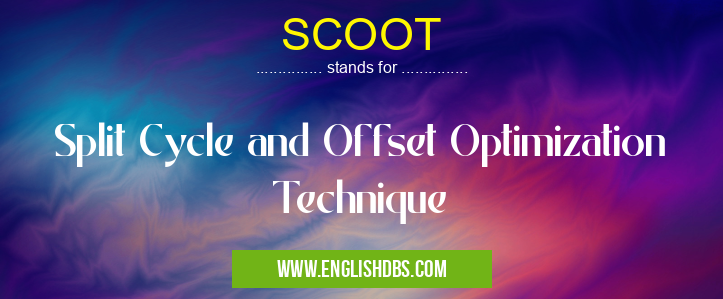What does SCOOT mean in TRANSPORTATION
SCOOT is a traffic optimization system that utilizes split cycle and offset optimization techniques. This system provides an efficient and cost-effective solution for traffic coordinators to manage traffic networks and improve road safety, while reducing congestion. SCOOT can be used in both urban and rural settings to maximize the capacity of existing roads, reduce emissions, and improve road safety by allowing vehicles to move more smoothly through intersections.

SCOOT meaning in Transportation in Governmental
SCOOT mostly used in an acronym Transportation in Category Governmental that means Split Cycle and Offset Optimization Technique
Shorthand: SCOOT,
Full Form: Split Cycle and Offset Optimization Technique
For more information of "Split Cycle and Offset Optimization Technique", see the section below.
Essential Questions and Answers on Split Cycle and Offset Optimization Technique in "GOVERNMENTAL»TRANSPORTATION"
What is SCOOT?
SCOOT stands for Split Cycle and Offset Optimization Technique. It is a traffic optimization system that utilizes split cycle and offset optimization techniques to maximize the capacity of existing roads, reduce emissions, and improve road safety by allowing vehicles to move more smoothly through intersections.
How does SCOOT work?
The system works by gathering data from roadside detectors, such as cameras or sensors installed in the roads or motorways, which are then analyzed to identify traffic patterns or congested areas. Depending on the analysis results, signals are sent to any controllable devices on the roads such as corner signs or overhead gantries. These signals then adjust the phase duration so that traffic flows more efficiently during peak hours.
What are the benefits of using SCOOT?
By using SCOOT as a traffic optimization system, it can help reduce emissions as well as improve road safety by allowing vehicles to move more smoothly through intersections. Additionally, it can also save fuel costs by optimizing vehicle movement which leads to less stop-start driving conditions. It also helps reduce congestion since signals can be adjusted so that green time is longer during peak hours when cars need it most.
Where can I find out more about SCOOT?
More information about SCOOT can be found online on websites such as the U.S Department of Transportation's website or other traffic engineering resources such as those provided by universities or research institutes.
Is there any downside to using this technology?
One potential downside may be that drivers may become complacent if they feel like they know what will happen at each intersection due to predicable patterns generated from this technology. This could potentially lead them into taking risks or making unsafe decisions due to false reassurance from prior experience with these technologies.
Final Words:
In conclusion, SCOOT is an effective tool for managing traffic flow and improving road safety for pedestrians and motorists alike. With its ability to gather data from roadside detectors combined with its automated signal adjustments based on the data analysis results, it has become a popular choice for many cities around the world looking for efficient ways of managing their transportation networks.
